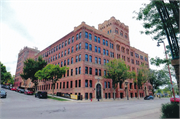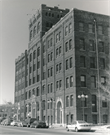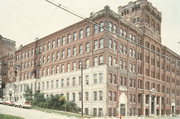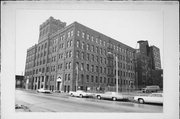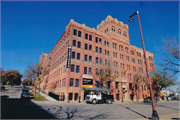Property Record
100 E PLEASANT ST (AKA 116 E WALNUT ST OR 1726 N 1ST ST)
Architecture and History Inventory
| Historic Name: | Mayer Boot and Shoe Company Building (F. Mayer) |
|---|---|
| Other Name: | F. MAYER BOOT & SHOE CO |
| Contributing: | |
| Reference Number: | 16744 |
| Location (Address): | 100 E PLEASANT ST (AKA 116 E WALNUT ST OR 1726 N 1ST ST) |
|---|---|
| County: | Milwaukee |
| City: | Milwaukee |
| Township/Village: | |
| Unincorporated Community: | |
| Town: | |
| Range: | |
| Direction: | |
| Section: | |
| Quarter Section: | |
| Quarter/Quarter Section: |
| Year Built: | 1892 |
|---|---|
| Additions: | 1899 |
| Survey Date: | 1982 |
| Historic Use: | industrial bldg/manufacturing facility |
| Architectural Style: | Romanesque Revival |
| Structural System: | |
| Wall Material: | Brick |
| Architect: | H. Schnetzky & Co |
| Other Buildings On Site: | |
| Demolished?: | No |
| Demolished Date: |
| National/State Register Listing Name: | Mayer Boot and Shoe Company Building |
|---|---|
| National Register Listing Date: | 8/2/1984 |
| State Register Listing Date: | 1/1/1989 |
| National Register Multiple Property Name: | Multiple Resources of N. 3rd St. - Brewers' Hill |
| Additional Information: | A 'site file' exists for this property. It contains additional information such as correspondence, newspaper clippings, or historical information. It is a public record and may be viewed in person at the Wisconsin Historical Society, Division of Historic Preservation. National Register Nomination has an official address of 116 E Walnut. However, E. Walnut Street was renamed E. Pleasant St. ARCHITECTURAL STATEMENT: Description: The F. Mayer Boot and Shoe Company building is a "U" shaped, eight-story brick design with mixed stylistic influences. The south front elevation is a symmetrical composition divided into three primary units consisting of 11 structural bays. The center portion is three bays wide, and is the portion which is eight stories high. It projects two stories above the rest of the building and forms a tower with a crenelated parapet. The windows in this portion are round arch openings, paired under large arches on the seventh floor and small groups of three on the eighth floor. All the other windows on the building are segmental arch openings, grouped in pairs on the front facade and evenly spaced on the sides. The structural bays are delineated by pilasters, which terminate at the corbelled cornice near the top. The lower two floors of the south elevation are treated in a different manner than floors three through six. Two-story high pilasters mark the center entry, flanked by two-story round arch door openings in the center of each three side bays. All three entries have Neo-Classic Revival detailing. However, the tower has a Romanesque flavor, creating an overall effect of Victorian eclecticism. The current structure is the result of many additions and remodelings. The original building of 1880 stood at the corner of First and Walnut. It was a two-story structure with hipped roof having dormers on the First Street side and a gable on the Walnut Street side. This first factory was four bays wide. In 1884 when the stock company was organized with Mayer and his sons as officers, an addition was built to the east of the original. It likewise was two stories high with dormers. It continued the facade and lengthened it by seven bays. An additional eight bays were constructed before 1892. By 1892 the growth in business required another addition. The corner section at First and Walnut was rebuilt entirely into a five-story structure, 42' x 135', at a cost of $20,000. The architect was H. Schnetzky and Company. Entrance into the five bay front was through a simple central arch, almost two stories high. A parapet with a pyramidal roof served to accent the corner bay at First and Walnut, while similar treatment finished off the rear of the building along the First Street facade. This west portion exists today but modified. In 1895 an additional story was added at a cost of $3,000. In 1899, what remained of the low, two-story factory to the east was lost to another rebuilding. A five-story structure was added at the cost of $30,000 and was designed by architect E. R. Liebert. Later additions and modifications were made to the factory but the main facade on Walnut Street has remained uniform. Both the central addition and easternmost five-bay section are six stories high. Fenestration is horizontally consistent in each of the three units. A strong cornice line serves to cap the building. This is surmounted in the central unit by a one-story tower. The easternmost unit repeats the central arch opening of the earlier, west unit from 1892. Further additions were built along First Street in 1906 and 1912. The integrity of this facility is exceptional. The exterior has virtually retained its original appearance from when the last addition was constructed in 1912. The interior production spaces have also maintained their integrity as evidenced by the original support members and finishes. HISTORICAL STATEMENT: Frederick Mayer was born in 1823, coming to Milwaukee from Darmstadt, Germany. In 1852 he started a retail shoe business at 318 West Water Street which was enlarged several times. In 1880 he established a shoe manufacturing business in a two-story building at North First and East Walnut Streets. (B). The shore and boot company was formally organized in 1884 with capital of $200,000. Mayer was president with three sons working under him: A.J. was vice-president, George P. was secretary-treasurer, and Fred, Jr. was superintendent. At that time, a two-story addition was made to the original building, followed by the first portion of the present building in 1892. After several expansions, plant capacity rose from the original 150 pairs of shoes per day to 3,000 pairs per day. F. Mayer Boot & Shoe Company was well known for its "Milwaukee oil grain goods" said to be unrivaled for comfort, wearing quality, and ability to keep out wetness. By 1893, the company employed 125 workers. (C). Mayer, Sr. died in 1897. The business was in the building until 1934; it remained in use for shoe manufacturing until 1938, after which many other firms have occupied it. Various procedures of the shoe manufacturing business occupied the building: basement - sole leather; first - packing; second - finishing; third - fitting; fourth - stitching; fifth - cutting; and sixth - storage. (A). The F. Mayer Boot & Shoe Company represents one facet of the giant tanning industry which made Milwaukee a leader in the country. The Brewers' Hill area saw the largest concentration of tanneries along the banks of the Milwaukee River. Manufacturers such as the U. Schoenecker Boot & Shoe Company and the Mayer plant were located in the proximity to the supply of tanned leather. By 1910, in a period of property for the leather industry as a whole, Mayer had expanded nationwide and established a five-story building in Seattle to meet the demand for shoes along the West Coast and Alaska. |
|---|---|
| Bibliographic References: | A. 1910 Sanborn Insurance Map. B. Commercial History of Milwaukee, 1910. C. "Milwaukee of Today: The Cream City of the Lakes." Milwaukee, (no date, 1892), p. 84. D. Commercial History of Wisconsin. Milwaukee Press Club, 1910, p. 96. E. Tax Program. F. Comm. File- F. Mayer. G. Commercial Milwaukee, 1909; p. 97. |
| Wisconsin Architecture and History Inventory, State Historic Preservation Office, Wisconsin Historical Society, Madison, Wisconsin |

